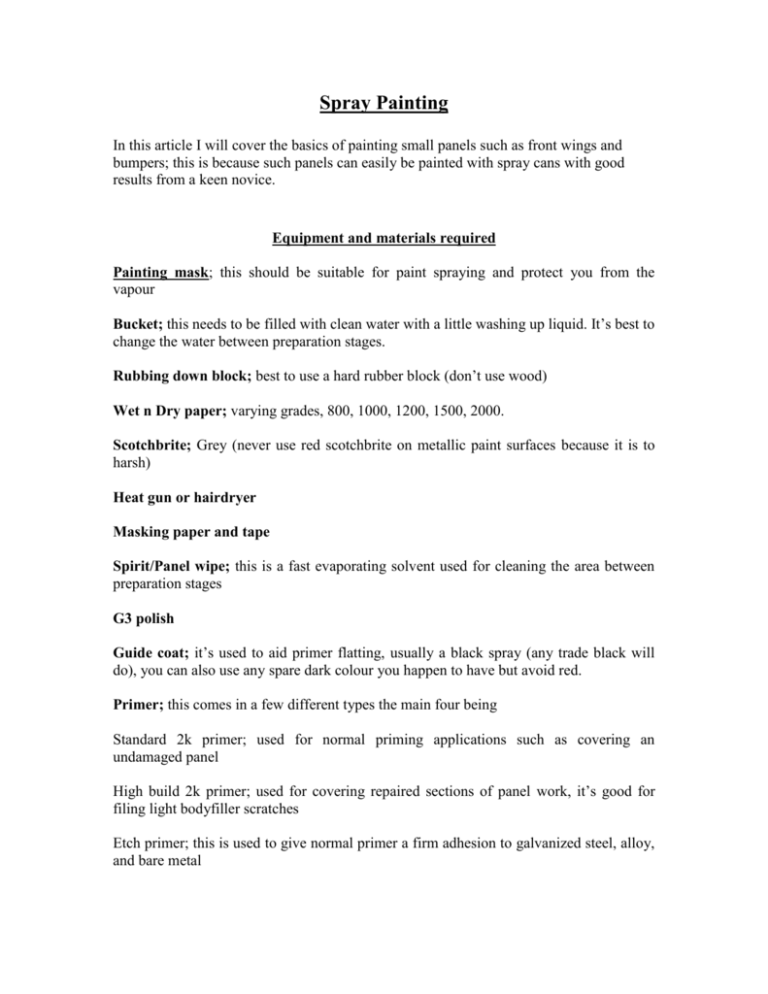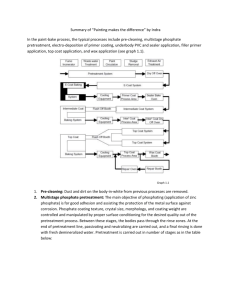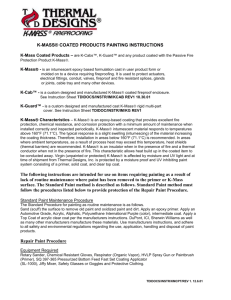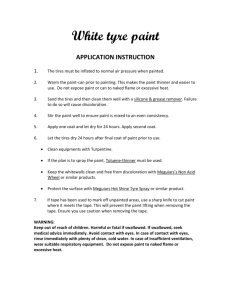Spray Painting 101
advertisement

Spray Painting In this article I will cover the basics of painting small panels such as front wings and bumpers; this is because such panels can easily be painted with spray cans with good results from a keen novice. Equipment and materials required Painting mask; this should be suitable for paint spraying and protect you from the vapour Bucket; this needs to be filled with clean water with a little washing up liquid. It’s best to change the water between preparation stages. Rubbing down block; best to use a hard rubber block (don’t use wood) Wet n Dry paper; varying grades, 800, 1000, 1200, 1500, 2000. Scotchbrite; Grey (never use red scotchbrite on metallic paint surfaces because it is to harsh) Heat gun or hairdryer Masking paper and tape Spirit/Panel wipe; this is a fast evaporating solvent used for cleaning the area between preparation stages G3 polish Guide coat; it’s used to aid primer flatting, usually a black spray (any trade black will do), you can also use any spare dark colour you happen to have but avoid red. Primer; this comes in a few different types the main four being Standard 2k primer; used for normal priming applications such as covering an undamaged panel High build 2k primer; used for covering repaired sections of panel work, it’s good for filing light bodyfiller scratches Etch primer; this is used to give normal primer a firm adhesion to galvanized steel, alloy, and bare metal Plastic primer; like the etch primer this is specially formulated to give normal primer good adhesion to plastics. Failure to use this can result in badly flaking paint. Paint; wherever possible it is advisable to use a spray gun and compressor for the best results especially on larger panels. That said on small panels or trims you can get good results from an aerosol can with time and care. The ford Probe is painted in three very different types of paint Solid colour; e.g. Rio red, Black Although solid colours technically come in two forms, solid 2k and 2k basecoat, usually it is only available as 2k solid colour in spray cans. 2k solid paint does not require a lacquer and can be polished to a shiny hard durable surface. Metallic Basecoat; e.g. Electric blue, Silver As the name suggests the paint contains really small particles of metallic glitter which gives the paint its sparkle. All metallic paints require the application of lacquer to give a hard polish able surface. Pearlescent Basecoat; e.g. Boysenberry Pearlescent paint is a very thin paint which contains really small plastic or glass beads, these beads refract the light falling on the paint giving it the apparent colour changing affect. This paint also requires a lacquer to give it its hard polish able surface, additionally it frequently requires an extra ground coat paint or tinted primer to achieve a good colour match and to give the paint its apparent depth. Consult your paint supplier to get the correct colour ground coat. Lacquer; required by all basecoat paints to give a hard, polish able and durable surface. *note* when choosing your spray paints and primers try to avoid the older cellulose paints opting instead for the more modern 2k paints. Don’t mix coats of cellulose and 2k paints or you will at best get a poor quality finish and at worst get a major paint reaction and have to strip the panel and start again. Workspace and vehicle preparation Always make sure your working in a clean uncluttered area with plenty of room to move around the job. If you are working in a garage sweep the floor and dust sheet as much as possible. It also helps to dampen the floor to reduce dust getting kicked up when you are walking around. If you are working outside then you’re at the mercy of the elements, I think it goes without saying that you need a warm dry day with as little wind as possible. The same workspace preparation goes for working outside. If you’re only painting the one panel then its best to remove this panel from the car if viable, things like bonnets, bumpers, spoilers and bits of painted trim are easy to remove and so much easier to work on off the car and on a table, box or workmate so they aren’t on the ground . It’s also best to remove as much as possible from the panel you are working on. E.g. on the bonnet, the washer jets, sound deadening pad and rubber trims can all be removed. This not only stops them getting overspray on them, it also eliminates paint edges caused by masking them up. If you are painting panels like the rear quarter it is better to remove the likes of the rear lights and loosen the edge of the bumper rather than risk damage due to flatting and paint edges caused by masking. Always protect any adjacent panels with masking tape before you start work The example job is painting a spoiler with a small filler repair and a metallic color change. If you are working on a metal panel, then replace the plastic primer stages for etch primer Stages can be skipped depending on their relevance Panel preparation priming and painting Before you start give the panel a good clean with panel wipe. Concentrating firstly on the filler repair; the filler should have been finished in 600WnD. Check the repairs shape by hand making sure it flows with the lines of the spoiler, there aren’t any lumps or dips and that there aren’t any pin holes or pits in the filler. If you are happy with the shape of the repair then give the surrounding area of paint a flatting with 800WnD to get rid of any heavy flatting scratches. Then give the filler a light going over with the 800WnD to reduce any 600 scratches remembering that you are removing material so it will affect the shape if it’s overdone. Check the rest of the panel for scratches, any scratches found should be flatted down with 800WnD and the surrounding paint edge feathered (as described in “flaking lacquer”) Give the whole spoiler another wash, dry and panel wipe to clean it of any contaminants Any exposed areas of plastic need to be treated with a coat of plastic primer, allow the plastic primer to “flash off” and then give the scratched and repaired areas two or three coats of High build primer. When the last coat of high build primer has flashed off apply a very light dust coat of the guide coat, a dust coat is achieved by doubling the usual spraying distance, you are looking for a fine speckled effect. Allow the high build primer to fully cure; this time depends on the manufacturers specs found on the side of the can, the curing time can be reduced by the light application of heat with the heat gun. Don’t over heat the job or the primer will bubble and burn When the primer is fully cured start flatting it down with 1000WnD, you will notice that the guide coat you applied starts to vanish, use this as a guide to know when all the high build is flat by ensuring the entire black guide coat is gone. With the grey scotchbrite and plenty of water give the whole spoiler a going over, making sure all the corners and edges are flatted. Wash, dry and panel wipe the whole spoiler to remove contaminants. If you have the facility’s hang up the spoiler so you can get to all the sides at once. If you can’t hang the spoiler up then start with the under side then when that is cured prime the topside If during the flatting process you broke through to the plastic then treat the exposed plastic with a coat of plastic primer and allow it to flash The following stage can be skipped if you are not changing the color. You will need to give the spoiler three to four coats of standard primer making sure all the edges and corners are covered, as with the high build primer after the last coat has flashed apply a dusting of guide coat. Allow the primer to cure fully, aiding if necessary. Flat the primer with 1200WnD again using the black guide coat to tell if it’s flat. Once the entire guide coat has gone, give the whole spoiler a light flatting with the 1500WnD to remove the 1200 scratches Wash, dry and panel wipe the whole spoiler to remove contaminants Re hang the spoiler ready for the basecoat Apply the basecoat in long even strokes; try to start spraying off the spoiler, bringing the fan of paint across the spoiler in a long steady continuous motion and stop spraying when the paint fan is off the other side of the panel. Keeping the spray can an even distance from the job at all times. You are going to be applying about three coats of basecoat or until you are sure you have complete coverage, allowing the paint to flash in between each coat. When you have applied your last coat of basecoat quickly check over the job making sure there aren’t any runs in the paint. If you do get a run in the basecoat allow the paint to cure fully, gently flat the run down with 1500WnD, wash, dry, panel wipe and apply another coat of basecoat. After your last coat of basecoat has flashed, start applying the lacquer using the same technique as for the basecoat of long smooth continuous strokes. Again you want to apply three to four coats depending on how light you do them. Try to make the last coat of lacquer a nice wet coat to reduce the stipple effect. Allow the lacquer to fully cure before flatting and polishing. Flatting and polishing Once the paint is fully cured its time to polish. Take the 2000WnD on your rubber block and plenty of clean water with a little washing up liquid. Start by feeling your paint finish, inevitably you will have little bits of dust in the paint finish gently flat these down until you can’t feel them anymore, then go over the rest of the area to reduce the orange peel and slight rippling of the paint finish. Don’t over do it when flatting, remembering that you are removing lacquer and on sharp edges its easy to flat through the lacquer. Try to avoid any awkward curves and edges when flatting as you will need to be able to get in to these areas with the polish to remove the 2000 scratches Once you are happy that as much of the dust and orange peel has gone give the spoiler a wash and dry. You will need to use G3 on a clean cloth with plenty of water and elbow grease. Keep cleaning and checking as you go. A tip is to concentrate on a small area at a time getting that bit done before moving on to the next Remember G3 is abrasive; you are replacing 2000WnD scratches with finer polish scratches and to do this the polish wears down the lacquer. Once you are happy all the flatting marks are gone and it has a nice shine, give the whole panel a quick going over with a lighter polishing compound and finish in your favorite wax.
![[Agency] recognizes the hazards of lead](http://s3.studylib.net/store/data/007301017_1-adfa0391c2b089b3fd379ee34c4ce940-300x300.png)




